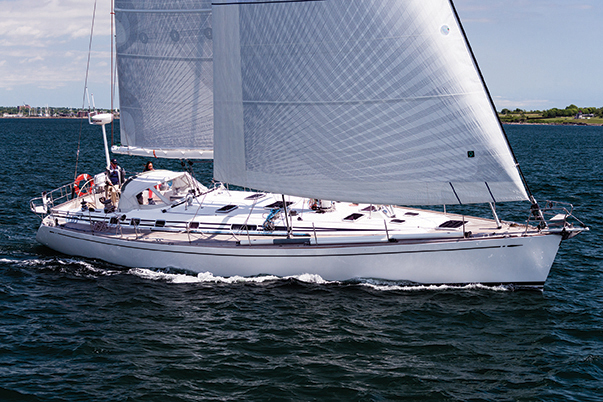As yacht design and engineering becomes more refined with the use of exotic materials in the hull and rig, sometimes disguised to look traditional such as a carbon mast covered with a wood veneer, sailmakers are also getting in on the game building high tech sails for cruising boats (published April 2016)
These sails may be a laminate that incorporates some exotic fibers there to handle high loads, or they may be as sophisticated as a loadpath membrane sail engineered perfectly to handle the expected loads and to maintain optimal sail shape through a variety of conditions. Increasingly sailmakers are seeing a demand for high tech sails for cruisers. In part one of this two part series on fabric and engineering for sails we took a close look at Dacron and the different ways it is used to build sails. In this article we will explore some of the more highly engineered ways to build your inventory and the modern fibers that are used to come up with the perfect sail.
THE SAILMAKER’S GOAL
Let’s remind ourselves why we might want to have a sail that incorporates all this new technology if all we are doing is cruising and not racing. What sailmakers strive to do is to build you a sail that is strong enough to handle the expected conditions, but also to make that sail as light as possible. There are a number of reasons for this. Light sails are easier to handle and they take up less storage space. They are also easier to set and trim. One often overlooked reason to have a light sail is that you can reduce weight aloft. Reducing weight aloft reduces the heeling and pitching moment which is important on long offshore passages. A smoother ride is less taxing on the crew. You would be surprised how much difference a twenty pound bag of sand strapped to your mast near the top changes how a boat sails.
So the goal is to build strong sails that are as light as possible and still get the job done. The goal is also to make sure that the sail is durable and can last for many years even in tough sailing areas like the tropics where UV can be very damaging. The first step up from a cross-cut Dacron sail is to build a tri-radial sail. With a radial sail you can place heavier fabric in the high load areas like the leech and foot, and lighter fabric in the body of the sail. This is much more efficient than cross-cut where you have the same weight fabric throughout the sail. To build a tri-radial sail you need a laminate and as already discussed there is a lot that can go into the engineering of laminated fabric.
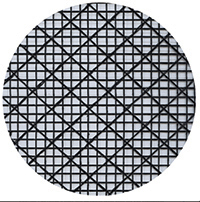
WHAT LAMINATE IS MADE OF
As the name suggests a laminate is made up of a number of layers all glued together. There is theoretically no limit to the number of layers you can stack on top of each other but it’s important to be as precise as possible about the job each layer is expected to do. This is where fabric engineering comes into play. You want the finished fabric to be as light as possible with the individual yarns each doing their part to take up the anticipated loads and to maintain the designed sail shape. At the heart of a laminate is a mylar film there to handle any off-threadline loads. Usually for cruising sails there will be light polyester taffetas on the outside layers. These taffetas will have been treated with anti-mildew and anti-UV additives and are there to protect the delicate load bearing yarns from chafe and the damaging effect from the sun.
What you layer in between is up to the fabric engineer and he/she has a lot to work with. A couple of decades ago all you had was Polyester (Dacron) but thanks largely to the defense industry developing new fibers there are a lot more choices for fabric engineers. One example is Vectran. Vectran is one of the super-fibers used in sailmaking. It’s a liquid crystal polymer that, pound for pound, is five times stronger than steel and 10 times stronger than aluminum. It was originally developed to be used as a towing line that would tow listening devices behind submarines. The line needed to stay a precise distance behind the submarine so that they could tune out the engine noise. If the line elongated it would be a problem. It turned out that Vectran was also an excellent fiber for sails. It has zero creep meaning that it does not elongate over time when under constant load, and has high chemical and abrasion resistance as well as high tensile strength. One of it’s drawbacks, however, is that it’s sensitive to that all important ingredient of a good day on the water; sunshine. With some clever engineering fabric makers have been able to make fabrics where the UV sensitive Vectran yarns are encapsulated between other fibers protecting them from the UV rays.
Another fiber that is dominating sailmaking these days is Carbon. Earlier use of Carbon in sails was a disaster because the fibers were too brittle and snapped easily, but the strength and stretch resistance that Carbon offered was too good to pass up and fabric engineers worked with the companies that make Carbon to develop a fiber that was able to take some bending and flexing without breaking, and they were successful. Carbon is one of the most popular high tech fibers used in sailmaking these days.
A few years ago Kevlar was all the rage but now Twaron has taken over from Kevlar. Twaron is very similar to Kevlar in terms of strength and stretch resistance but without the UV and flex issues that plagued Kevlar sails in the past. It’s a much more suitable fiber for sails and is becoming increasingly popular. Another popular fiber is Technora which is a black yarn similar in modulus (it’s ability to resist stretch) to Kevlar with a slightly better flex capacity. The raw fiber is in fact gold, but fabricmakers dye the yarns black to improve its tolerance to UV.
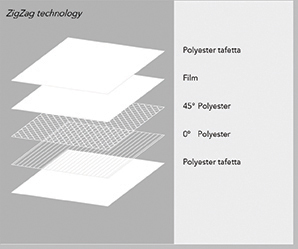
Even Polyester got a makeover with the development of a fiber called polyethylene napthalate, or Pentex for short. Pentex was developed for the tire and mechanical rubber markets and has several features that make it well suited for sailcloth applications including the fact that it is rugged and has two and a half times the modulus, or stretch resistance, of regular Dacron. This translates into two and a half times less stretch than Polyester/Dacron sails of equal weight.
So as you can see fabric makers and sail engineers have a plethora of choices when it comes to making new sails for your boat and the old adage is particularly true as it relates to sailmaking; you do get what you pay for. If your laminate has a layer of Carbon and Twaron you have some pretty potent fibers there to help maintain optimum sail shape through a variety of conditions. If it’s Polyester or Pentex it may not be as good as Technora or Twaron, but it’s definitely better than a woven Dacron at least in terms of strength for weight.
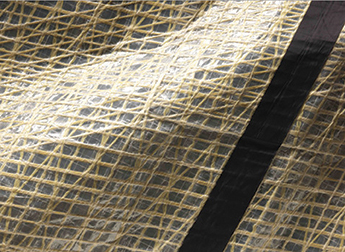
Since molded sails were first developed, the race to build the best laminated sails has been fierce with a variety of opinions touting all sides of the argument. Let me explain. One of the key elements to manufacturing any kind of laminate is the amount of pressure you can bring to bear on the surface of the fabric. More pressure means less adhesive for the same bond. Less adhesive means a lighter sail so the companies that manufacture bolts of laminated sailcloth will claim, and probably rightly so, that pound for pound their fabric is stronger than a molded sail and also less likely to delaminate. Bolts of sailcloth are 54 inches wide; molded sails, by contrast, are made on a massive mold and as such you are not able to exert the same pressure as you can on a bolt of cloth.
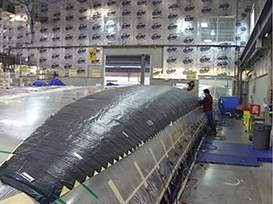
Somewhere between paneled sails and molded sails are membrane sails that are manufactured as large panels and then sewn together. These are loadpath sails similar to those manufactured on a mold, but the difference is that they have seams running across the sail. The large panels have the yarns laid down in a pattern specified by the sail engineer and when the panels are stitched together it appears as if the yarns run continuously from the foot of the sail to the head where in fact they stop and start at each seam. Because these panels are not as large as an entire mold you are able to exert a decent amount of pressure on the laminate; more than a molded sail but less than a 54 inch bolt of cloth.
It’s clearly getting complicated and for the average sailor out there it’s getting more and more confusing, but the good news is the sails are better engineered and they last a lot longer. My old friend Skip Novak, with whom I have sailed almost a 100,000 miles, would rail against anything other Dacron for a boat going offshore. His boats spend much of their time crossing the Drake Passage to Antarctica and sail failure is simply not an option. Recently he was talked into a membrane staysail and loves it. You can’t ignore progress and sails are no different.
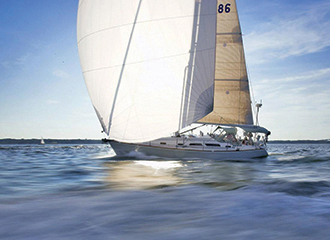
Deciding whether or not a high tech sail is a good option for you really depends upon your boat, your budget, and your sailing plans. Dacron has always and will more than likely continue to be a great option for cruisers. Some sailors like the look of white cross-cut sails and would never entertain the idea of a yellow or black sail on their boat. Other sailors who have a fin keel and spade rudder below the waterline of their traditional looking yawl might want to compliment the modern appendages with modern sails disguised as traditional. Either way I think it’s worth repeating; you should not measure the length of a sails life simply but how long it holds together. A more useful measure is by how long it holds it’s shape and with all the tools at a sailmakers disposal chances are you can now get a sail that will hold its shape for many years.
Brian Hancock is a sailmaker, author, lecturer and veteran offshore sailor.















